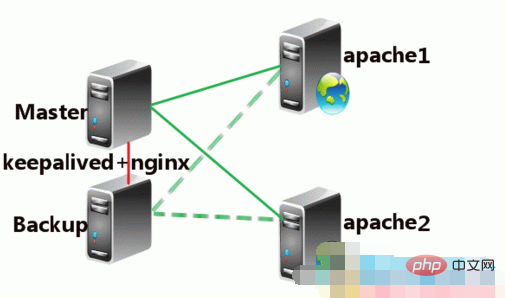Can nginx be clustered?

Can nginx be clustered?
nginx realizes cluster high availability
Everyone knows that NGINX can achieve load balancing as a reverse proxy server and can also be used as a static file server. Its characteristics That is, the concurrency support is large, and a single machine can support 30,000 concurrencies at the same time. Now many websites use NGINX as a gateway portal to uniformly schedule and allocate back-end resources. However, if NGINX goes down, the entire backend service will be unusable; or when the concurrency is really large, reaching the level of 100,000, there is still a limit to one NGINX, so at this time, it is necessary to perform master-slave operation on NGINX. Backup ensures high availability of services, and clusters are used to share concurrency pressure. Currently, NGINX mainly has the following solutions in these two areas. I will introduce them to you respectively:
NGINX master-slave backup
NGINX currently implements master-slave backup The mainstream solution is Keepalived Nginx to implement dual-machine hot backup.
Keepalived introduction:
Keepalived is a service high-availability solution based on the VRRP protocol. It can be used to avoid IP single points of failure. Similar tools include heartbeat, corosync, and pacemaker. But it generally does not appear alone, but works together with other load balancing technologies (such as lvs, haproxy, nginx) to achieve high availability of the cluster.
VRRP protocol:
The full name of VRRP is Virtual Router Redundancy Protocol, which is the virtual routing redundancy protocol. It can be considered a fault-tolerant protocol to achieve high availability of routers. N routers that provide the same functions are formed into a router group. This group has a master and multiple backups, but it looks like one router to the outside world. , constitute a virtual router, with a virtual IP (vip, that is, the default route of other machines in the LAN where the router is located). The master that owns this IP is actually responsible for ARP response and forwarding IP packets, and other routers in the group serve as backup roles. Standby. The master will send multicast messages. When the backup fails to receive vrrp packets within the timeout period, it is considered that the master is down. At this time, a backup needs to be elected as the master based on the VRRP priority to ensure the high availability of the router.
In the VRRP protocol implementation, the virtual router uses 00-00-5E-00-01-XX as the virtual MAC address. XX is the unique VRID (Virtual Router IDentifier). This address only has one physical router at the same time. occupied. In the physical router group in the virtual router, notification messages are sent regularly through the multicast IP address 224.0.0.18. Each Router has a priority level between 1-255, and the highest priority will become the master router. By lowering the priority of the master, the router in the backup state can preempt (pro-empt) the state of the main router. The larger of the two IP addresses with the same backup priority is the master and takes over the virtual IP.
Specific implementation principle:
1) Master is not down, then Master occupies VIP and nginx is running on Master
2) Master is down, Then the backup seizes the VIP and runs the nginx service on the backup
3) If the nginx service on the master server hangs, the VIP resources are transferred to the backup server
4) Detect the back-end server Health status
Both Master and Backup have nginx services enabled. Regardless of Master or Backup, when one of the keepalived services stops, VIP will drift to the node where the keepalived service is still there

NGINX and keepalived installation and configuration
There are many installation configurations for them, as well as writing scripts to monitor each other, alarm, etc., so we will give a special lesson Lecture, this lesson mainly talks about solutions and principles.
NGINX Distributed Cluster
If there are multiple NGINX and you want to achieve load balancing,
1. Each nginx has a public network address. Setting multiple directions to the same domain name at the domain name is the easiest way to implement round robin. But the fault cut-off will be slower.
2. One public network nginx is distributed to multiple nginxes on the intranet through the upstream function, wheel, IP, and url. But if nginx on the public network is down, the entire internal network will be affected.
3. A pair of public network nginx plus three public network IPs, achieve high availability through keepalive, and then upstream to the intranet (this is the master-slave backup we just talked about in the previous section).
Generally speaking, the above 1, 2, and 3 methods can basically solve the problem. It is recommended to use 2 or 3;
If the amount of concurrency is really huge, it is generally necessary to use hardware F5 and other equipment To do load balancing, cooperate with DNS, CDN and other service providers to do domain name resolution forwarding and cache configuration. This is also the current architectural configuration of most major manufacturers.
For more Nginx related technical articles, please visit the Nginx usage tutorial column to learn!
The above is the detailed content of Can nginx be clustered?. For more information, please follow other related articles on the PHP Chinese website!

Hot AI Tools

Undresser.AI Undress
AI-powered app for creating realistic nude photos

AI Clothes Remover
Online AI tool for removing clothes from photos.

Undress AI Tool
Undress images for free

Clothoff.io
AI clothes remover

Video Face Swap
Swap faces in any video effortlessly with our completely free AI face swap tool!

Hot Article

Hot Tools

Notepad++7.3.1
Easy-to-use and free code editor

SublimeText3 Chinese version
Chinese version, very easy to use

Zend Studio 13.0.1
Powerful PHP integrated development environment

Dreamweaver CS6
Visual web development tools

SublimeText3 Mac version
God-level code editing software (SublimeText3)

Hot Topics
 How to check the name of the docker container
Apr 15, 2025 pm 12:21 PM
How to check the name of the docker container
Apr 15, 2025 pm 12:21 PM
You can query the Docker container name by following the steps: List all containers (docker ps). Filter the container list (using the grep command). Gets the container name (located in the "NAMES" column).
 How to configure nginx in Windows
Apr 14, 2025 pm 12:57 PM
How to configure nginx in Windows
Apr 14, 2025 pm 12:57 PM
How to configure Nginx in Windows? Install Nginx and create a virtual host configuration. Modify the main configuration file and include the virtual host configuration. Start or reload Nginx. Test the configuration and view the website. Selectively enable SSL and configure SSL certificates. Selectively set the firewall to allow port 80 and 443 traffic.
 How to check whether nginx is started
Apr 14, 2025 pm 01:03 PM
How to check whether nginx is started
Apr 14, 2025 pm 01:03 PM
How to confirm whether Nginx is started: 1. Use the command line: systemctl status nginx (Linux/Unix), netstat -ano | findstr 80 (Windows); 2. Check whether port 80 is open; 3. Check the Nginx startup message in the system log; 4. Use third-party tools, such as Nagios, Zabbix, and Icinga.
 How to start containers by docker
Apr 15, 2025 pm 12:27 PM
How to start containers by docker
Apr 15, 2025 pm 12:27 PM
Docker container startup steps: Pull the container image: Run "docker pull [mirror name]". Create a container: Use "docker create [options] [mirror name] [commands and parameters]". Start the container: Execute "docker start [Container name or ID]". Check container status: Verify that the container is running with "docker ps".
 How to configure cloud server domain name in nginx
Apr 14, 2025 pm 12:18 PM
How to configure cloud server domain name in nginx
Apr 14, 2025 pm 12:18 PM
How to configure an Nginx domain name on a cloud server: Create an A record pointing to the public IP address of the cloud server. Add virtual host blocks in the Nginx configuration file, specifying the listening port, domain name, and website root directory. Restart Nginx to apply the changes. Access the domain name test configuration. Other notes: Install the SSL certificate to enable HTTPS, ensure that the firewall allows port 80 traffic, and wait for DNS resolution to take effect.
 How to check nginx version
Apr 14, 2025 am 11:57 AM
How to check nginx version
Apr 14, 2025 am 11:57 AM
The methods that can query the Nginx version are: use the nginx -v command; view the version directive in the nginx.conf file; open the Nginx error page and view the page title.
 How to create containers for docker
Apr 15, 2025 pm 12:18 PM
How to create containers for docker
Apr 15, 2025 pm 12:18 PM
Create a container in Docker: 1. Pull the image: docker pull [mirror name] 2. Create a container: docker run [Options] [mirror name] [Command] 3. Start the container: docker start [Container name]
 How to start nginx server
Apr 14, 2025 pm 12:27 PM
How to start nginx server
Apr 14, 2025 pm 12:27 PM
Starting an Nginx server requires different steps according to different operating systems: Linux/Unix system: Install the Nginx package (for example, using apt-get or yum). Use systemctl to start an Nginx service (for example, sudo systemctl start nginx). Windows system: Download and install Windows binary files. Start Nginx using the nginx.exe executable (for example, nginx.exe -c conf\nginx.conf). No matter which operating system you use, you can access the server IP






